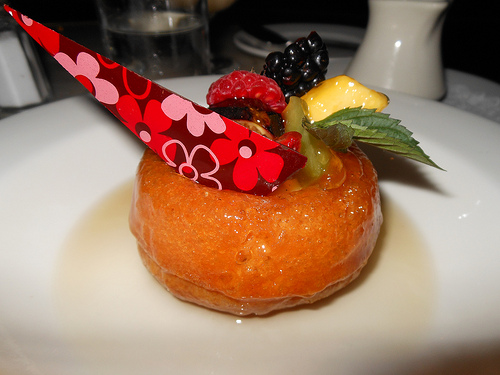In 1844, the Julien Brothers, Parisian pâtissiers, invented the savarin, which is strongly inspired by the baba au rhum, but is soaked with a different alcoholic mixture and uses a circular (ring) cake mould instead of the simple round (cylindrical) form.

How should the savarin be soaked and filled?
I think the easiest thing to do is to let a big savarin soak in the mould it was baked in (depending on the size 5-15 minutes). If you have small individual savarins and babas, just leave them soaking in a pot (around 2 minutes per side). In both cases, the syrup must not be hot but at room temperature (or slightly warm).
The good thing is that the syrup can be flavoured with virtually anything. Rum is perfect for this purpose and respects the tradition, but why not trying limoncello, or just an alcohol-free orange juice? (FYI, I tried Vodka and it was not that good)
Usually savarins and babas are not cut in two to be filled. They are glazed with apricot jam and then the flavour of the syrup is complemented with a cream on top of it (or inside the hole in the middle, if any) or fresh fruits.
You can use pastry cream, chantilly or a mix of both (the so-called diplomat cream). The flavour, once again, is up to your fantasy!
What is particular in the recipe of savarins/babas?
The basic ingredients of the recipe are quite simple: flour, yeast, eggs and butter. A lot of butter!
The proceedings, depending on the recipe, don’t differ much from the brioche, but the result is drier. Why is that?
The story teach us that the savarin was soaked because it was dry. Now it’s the opposite: the savarin must be dry because it has to be soaked in a sugar syrup, usually at 30 Brix (30% of sugar on the total weight of the syrup) for several minutes. Think of what happens when you dip cookies for more than 10 seconds in your tea and you’ll understand why you need the savarin to last a lot longer in a liquid.
How can you bake a product rich in butter so that it doesn’t fall apart when you soak it in a syrup? You need to use a very strong flour. Which flour? In the recipe of my vanilla and lime savarin, I wrote “bread flour“, which will help develop more gluten. In general, you should look for a high amount of protein when buying this flour at the supermarket, or a high “W” if you have access to professional flours.
I used a flour with 17% of proteins (pastry flour contains around 9%, bread flour 13-15%) : in France it is called “Farine de gruau“, in Italy “Manitoba“, and in English groats or groat flour (not 100% sure about this last one).
Baba & Savarin with David Blom | Baking With Julia Season 2 | Julia Child
FAQ
What is the difference between baba and babka?
What are the unique characteristics of savarin bread?
What is the history of savarin?
Where did the Italian dessert baba come from?
What is the difference between Babas & Savarin?
Some babas are baked in tall, cylindrical molds (especially in Russia and Ukraine) and savarins are baked in fluted ring molds. (In Poland, however, a baba, or babka, is baked in a fluted ring pan, making it virtually identical to a savarin in appearance.) A savarin is always served with sweetened whipped cream whereas a baba may not be.
Bavarian sauerkraut vs Regular sauerkraut: Which is healthier?
Sauerkraut is raw cabbage that has been finely cut and fermented. Both kinds of sauerkraut be it regular or Bavarian visually appear the same. This particular dish is native to Germany. It is available in cans or glass jars. Bavarian sauerkraut is milder and sweeter where as the regular German sauerkraut is sourer. The one which is fresh made adds up to a canned product as the canned product may have a lot of preservatives and is not good for health.
What is the difference between a baba au Rhum and a Savarin?
There are a few differences between a baba au rhum and a savarin, including the pan it’s baked in and how it is presented. While a baba typically has currants or other dried fruits in the dough, a savarin does not. Some babas are baked in tall, cylindrical molds (especially in Russia and Ukraine) and savarins are baked in fluted ring molds.
What is the difference between a soaked Babas and a Savarin?
Here is the size difference between an unsoaked baba and a soaked baba. Sprinkle babas with rum, glaze with apricot glaze, then top with sweetened whipped cream or pastry cream. Savarins, on the other hand, were soaked in raspberry (or another variation of) syrup.
